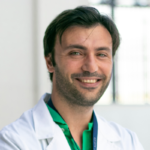
Simone Dario Scilabra, PhD
Group coordinator
sdscilabra@fondazionerimed.com
ADDRESS:
Department of Research ISMETT
Via Ernesto Tricomi,5
90127 PALERMO, Italy
Facilities:
Collaborations:
Institute for Aging and Chronic diseases, University of Liverpool, UK
German Center for Neurodegenerative Diseases (DZNE), Munich, Germany
Queen Mary University of London, UK
Norwich Medical School, University of East Anglia, Norwich, UK
Dipartimento di Scienze Farmacologiche, University of Pisa, Italy
Dipartimento di Scienze e Tecnologie Biologiche Chimiche e Farmaceutiche (STEBICEF), University ofPalermo, Italy
Weill Cornell Medicine Graduate School of Medical Sciences, New York, US
Description
Research in Scilabra’s Lab, which currently comprises a post-doc, 3 PhD students and an MSc intern, is focused on elucidating the role of a class of membrane-tethered metalloproteinases, called ADAMs (a disintegrin and metalloproteinases), in health and disease. For their ability to release cell surface proteins, ADAMs are involved in a number of cellular processes, including cell-communication, cell-adhesion and molecular transport. Our lab uses a synergistic array of proteomic, cell biology, biochemistry and in vivo models to identify substrates of ADAMs, validate them by orthogonal methods and uncover functional consequences of their ADAM-dependent release in vivo.
In detail, our studies are mainly centered on elucidating new functions of ADAM17 and its essential cofactors, the inactive rhomboid-like proteins 1 and 2 (iRhom1 and iRhom2) by using mass spectrometry-based approaches. Among others, Dr Scilabra’s lab is currently testing the hypothesis that iRhom2 inactivation has beneficial effects on OA progression by a dual role in inhibiting the release of TNF (a proinflammatory cytokine promoting the expression of cartilage catabolic factors) and LRP1, and endocytic receptor that reduces levels of cartilage-degrading proteases(Fondazione Con il Sud, N. 2018-PDR-00799, 01/09/2019 – 01/03/2023 “iRhom2: a new therapeutic target in osteoarthritis?”). In addition, his lab has recently found a new ADAM17-independent function of iRhom2 in aiding the maturation of MHC class I molecules and it is currently testing whether this mechanism has functional consequences in the recognition of cancer cells by the immune system or allograft transplantation (Piano Nazionale di Ripresa e Resilienza – Italian Ministry of University and Research (MIUR), DOT 1720429, CUP B73D21009330006; “Dissecting the role of iRhom2 in the autophagy of MHC-I molecules to enhance responsiveness of PDAC to immunotherapy”).
Team
